Ioannis Havoutis
Dynamic Robot Systems, Oxford Robotics Institute, University of Oxford
Sampling Strategies for Robust Universal Quadrupedal Locomotion Policies
Oct 08, 2025Abstract:This work focuses on sampling strategies of configuration variations for generating robust universal locomotion policies for quadrupedal robots. We investigate the effects of sampling physical robot parameters and joint proportional-derivative gains to enable training a single reinforcement learning policy that generalizes to multiple parameter configurations. Three fundamental joint gain sampling strategies are compared: parameter sampling with (1) linear and polynomial function mappings of mass-to-gains, (2) performance-based adaptive filtering, and (3) uniform random sampling. We improve the robustness of the policy by biasing the configurations using nominal priors and reference models. All training was conducted on RaiSim, tested in simulation on a range of diverse quadrupeds, and zero-shot deployed onto hardware using the ANYmal quadruped robot. Compared to multiple baseline implementations, our results demonstrate the need for significant joint controller gains randomization for robust closing of the sim-to-real gap.
Learning Physical Systems: Symplectification via Gauge Fixing in Dirac Structures
Jun 23, 2025Abstract:Physics-informed deep learning has achieved remarkable progress by embedding geometric priors, such as Hamiltonian symmetries and variational principles, into neural networks, enabling structure-preserving models that extrapolate with high accuracy. However, in systems with dissipation and holonomic constraints, ubiquitous in legged locomotion and multibody robotics, the canonical symplectic form becomes degenerate, undermining the very invariants that guarantee stability and long-term prediction. In this work, we tackle this foundational limitation by introducing Presymplectification Networks (PSNs), the first framework to learn the symplectification lift via Dirac structures, restoring a non-degenerate symplectic geometry by embedding constrained systems into a higher-dimensional manifold. Our architecture combines a recurrent encoder with a flow-matching objective to learn the augmented phase-space dynamics end-to-end. We then attach a lightweight Symplectic Network (SympNet) to forecast constrained trajectories while preserving energy, momentum, and constraint satisfaction. We demonstrate our method on the dynamics of the ANYmal quadruped robot, a challenging contact-rich, multibody system. To the best of our knowledge, this is the first framework that effectively bridges the gap between constrained, dissipative mechanical systems and symplectic learning, unlocking a whole new class of geometric machine learning models, grounded in first principles yet adaptable from data.
Reference Free Platform Adaptive Locomotion for Quadrupedal Robots using a Dynamics Conditioned Policy
May 21, 2025Abstract:This article presents Platform Adaptive Locomotion (PAL), a unified control method for quadrupedal robots with different morphologies and dynamics. We leverage deep reinforcement learning to train a single locomotion policy on procedurally generated robots. The policy maps proprioceptive robot state information and base velocity commands into desired joint actuation targets, which are conditioned using a latent embedding of the temporally local system dynamics. We explore two conditioning strategies - one using a GRU-based dynamics encoder and another using a morphology-based property estimator - and show that morphology-aware conditioning outperforms temporal dynamics encoding regarding velocity task tracking for our hardware test on ANYmal C. Our results demonstrate that both approaches achieve robust zero-shot transfer across multiple unseen simulated quadrupeds. Furthermore, we demonstrate the need for careful robot reference modelling during training, enabling us to reduce the velocity tracking error by up to 30% compared to the baseline method. Despite PAL not surpassing the best-performing reference-free controller in all cases, our analysis uncovers critical design choices and informs improvements to the state of the art.
Neural Associative Skill Memories for safer robotics and modelling human sensorimotor repertoires
May 14, 2025Abstract:Modern robots face challenges shared by humans, where machines must learn multiple sensorimotor skills and express them adaptively. Equipping robots with a human-like memory of how it feels to do multiple stereotypical movements can make robots more aware of normal operational states and help develop self-preserving safer robots. Associative Skill Memories (ASMs) aim to address this by linking movement primitives to sensory feedback, but existing implementations rely on hard-coded libraries of individual skills. A key unresolved problem is how a single neural network can learn a repertoire of skills while enabling fault detection and context-aware execution. Here we introduce Neural Associative Skill Memories (ASMs), a framework that utilises self-supervised predictive coding for temporal prediction to unify skill learning and expression, using biologically plausible learning rules. Unlike traditional ASMs which require explicit skill selection, Neural ASMs implicitly recognize and express skills through contextual inference, enabling fault detection across learned behaviours without an explicit skill selection mechanism. Compared to recurrent neural networks trained via backpropagation through time, our model achieves comparable qualitative performance in skill memory expression while using local learning rules and predicts a biologically relevant speed-accuracy trade-off during skill memory expression. This work advances the field of neurorobotics by demonstrating how predictive coding principles can model adaptive robot control and human motor preparation. By unifying fault detection, reactive control, skill memorisation and expression into a single energy-based architecture, Neural ASMs contribute to safer robotics and provide a computational lens to study biological sensorimotor learning.
Improving Trajectory Stitching with Flow Models
May 12, 2025Abstract:Generative models have shown great promise as trajectory planners, given their affinity to modeling complex distributions and guidable inference process. Previous works have successfully applied these in the context of robotic manipulation but perform poorly when the required solution does not exist as a complete trajectory within the training set. We identify that this is a result of being unable to plan via stitching, and subsequently address the architectural and dataset choices needed to remedy this. On top of this, we propose a novel addition to the training and inference procedures to both stabilize and enhance these capabilities. We demonstrate the efficacy of our approach by generating plans with out of distribution boundary conditions and performing obstacle avoidance on the Franka Panda in simulation and on real hardware. In both of these tasks our method performs significantly better than the baselines and is able to avoid obstacles up to four times as large.
MetaSym: A Symplectic Meta-learning Framework for Physical Intelligence
Feb 23, 2025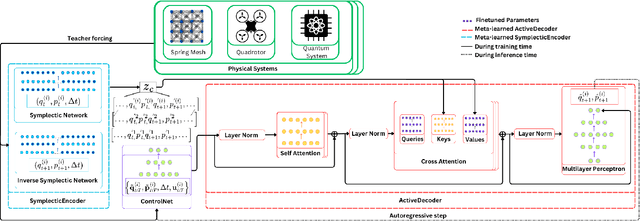

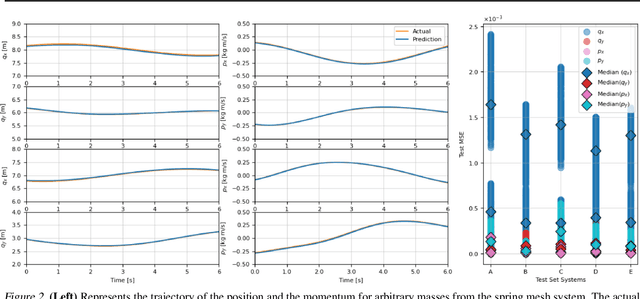

Abstract:Scalable and generalizable physics-aware deep learning has long been considered a significant challenge with various applications across diverse domains ranging from robotics to molecular dynamics. Central to almost all physical systems are symplectic forms, the geometric backbone that underpins fundamental invariants like energy and momentum. In this work, we introduce a novel deep learning architecture, MetaSym. In particular, MetaSym combines a strong symplectic inductive bias obtained from a symplectic encoder and an autoregressive decoder with meta-attention. This principled design ensures that core physical invariants remain intact while allowing flexible, data-efficient adaptation to system heterogeneities. We benchmark MetaSym on highly varied datasets such as a high-dimensional spring mesh system (Otness et al., 2021), an open quantum system with dissipation and measurement backaction, and robotics-inspired quadrotor dynamics. Our results demonstrate superior performance in modeling dynamics under few-shot adaptation, outperforming state-of-the-art baselines with far larger models.
Discovery of skill switching criteria for learning agile quadruped locomotion
Feb 10, 2025Abstract:This paper develops a hierarchical learning and optimization framework that can learn and achieve well-coordinated multi-skill locomotion. The learned multi-skill policy can switch between skills automatically and naturally in tracking arbitrarily positioned goals and recover from failures promptly. The proposed framework is composed of a deep reinforcement learning process and an optimization process. First, the contact pattern is incorporated into the reward terms for learning different types of gaits as separate policies without the need for any other references. Then, a higher level policy is learned to generate weights for individual policies to compose multi-skill locomotion in a goal-tracking task setting. Skills are automatically and naturally switched according to the distance to the goal. The proper distances for skill switching are incorporated in reward calculation for learning the high level policy and updated by an outer optimization loop as learning progresses. We first demonstrated successful multi-skill locomotion in comprehensive tasks on a simulated Unitree A1 quadruped robot. We also deployed the learned policy in the real world showcasing trotting, bounding, galloping, and their natural transitions as the goal position changes. Moreover, the learned policy can react to unexpected failures at any time, perform prompt recovery, and resume locomotion successfully. Compared to discrete switch between single skills which failed to transition to galloping in the real world, our proposed approach achieves all the learned agile skills, with smoother and more continuous skill transitions.
Offline Adaptation of Quadruped Locomotion using Diffusion Models
Nov 13, 2024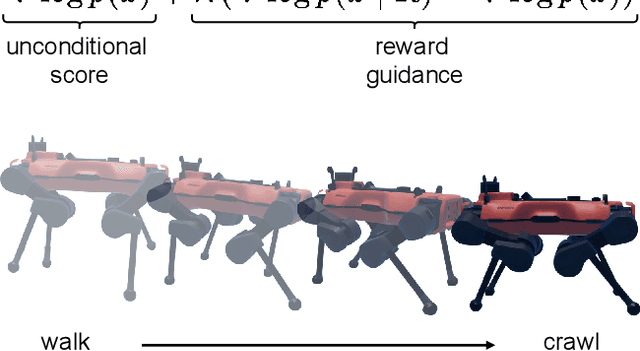

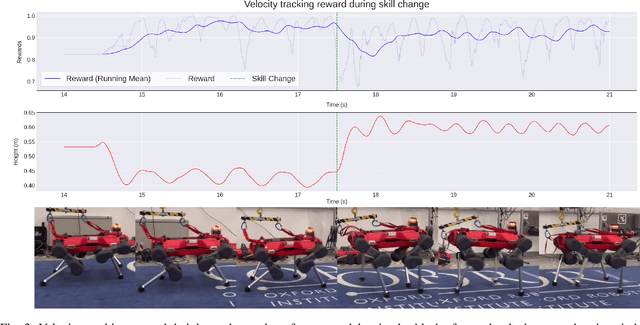
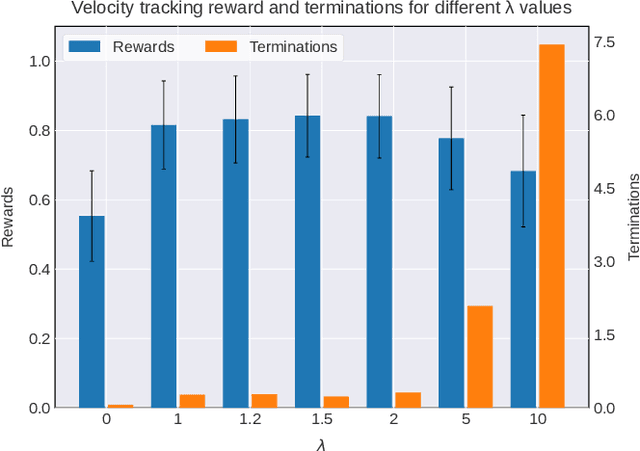
Abstract:We present a diffusion-based approach to quadrupedal locomotion that simultaneously addresses the limitations of learning and interpolating between multiple skills and of (modes) offline adapting to new locomotion behaviours after training. This is the first framework to apply classifier-free guided diffusion to quadruped locomotion and demonstrate its efficacy by extracting goal-conditioned behaviour from an originally unlabelled dataset. We show that these capabilities are compatible with a multi-skill policy and can be applied with little modification and minimal compute overhead, i.e., running entirely on the robots onboard CPU. We verify the validity of our approach with hardware experiments on the ANYmal quadruped platform.
Constrained Skill Discovery: Quadruped Locomotion with Unsupervised Reinforcement Learning
Oct 10, 2024
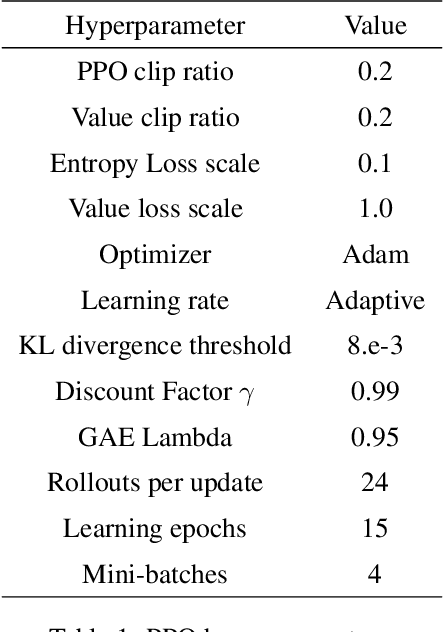
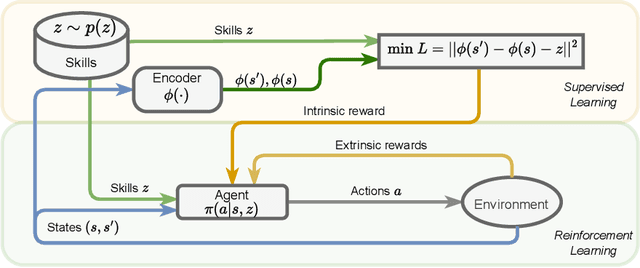
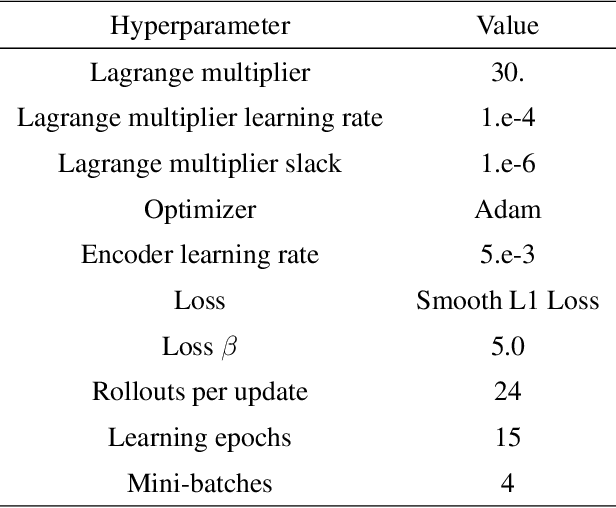
Abstract:Representation learning and unsupervised skill discovery can allow robots to acquire diverse and reusable behaviors without the need for task-specific rewards. In this work, we use unsupervised reinforcement learning to learn a latent representation by maximizing the mutual information between skills and states subject to a distance constraint. Our method improves upon prior constrained skill discovery methods by replacing the latent transition maximization with a norm-matching objective. This not only results in a much a richer state space coverage compared to baseline methods, but allows the robot to learn more stable and easily controllable locomotive behaviors. We successfully deploy the learned policy on a real ANYmal quadruped robot and demonstrate that the robot can accurately reach arbitrary points of the Cartesian state space in a zero-shot manner, using only an intrinsic skill discovery and standard regularization rewards.
InteLiPlan: Interactive Lightweight LLM-Based Planner for Domestic Robot Autonomy
Sep 22, 2024Abstract:We introduce a lightweight LLM-based framework designed to enhance the autonomy and robustness of domestic robots, targeting onboard embodied intelligence. By addressing challenges such as kinematic constraints and dynamic environments, our approach reduces reliance on large-scale data and incorporates a robot-agnostic pipeline. Our framework, InteLiPlan, ensures that the LLM model's decision-making capabilities are effectively aligned with robotic functions, enhancing operational robustness and adaptability, while our human-in-the-loop mechanism allows for real-time human intervention in the case where the system fails. We evaluate our method in both simulation and on the real Toyota HSR robot. The results show that our method achieves a 93% success rate in the fetch me task completion with system failure recovery, outperforming the baseline method in a domestic environment. InteLiPlan achieves comparable performance to the state-of-the-art large-scale LLM-based robotics planner, while guaranteeing real-time onboard computing with embodied intelligence.
 Add to Chrome
Add to Chrome Add to Firefox
Add to Firefox Add to Edge
Add to Edge